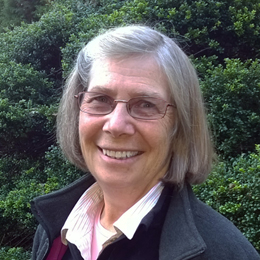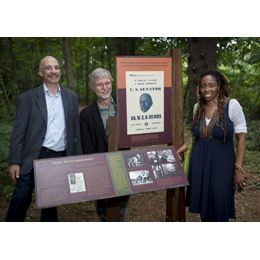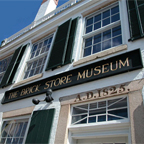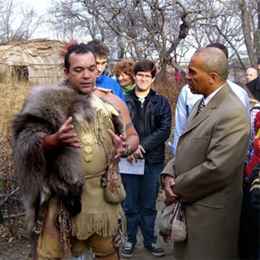This feature introduces you to colleagues in museums around New England. It’s often too easy for colleagues to feel isolated in their institutions—we hope this feature will break down the distances a bit. We also hope that it will reinforce your own enthusiasm for your work and cause you to reflect on the positive contributions that you make.
At the NEMA Annual Conference last November we announced the winners of the first ever NEMA Excellence Awards. Each winner demonstrated extraordinary effort and commitment to the New England museum community. Their work makes us better as a community of museum professionals and as a field and we would like to highlight them in this feature. The following are excerpts from their nominations.

Alexandra Allardt, Principal and Managing Director, ArtCare Resources
Alex Allardt is a highly skilled independent museum consultant who has shown a commitment to helping small museums, historic sites, and public agencies understand and solve collection preservation challenges, and also address the larger issues of institutional governance, mission, public awareness and participation so important to the health of the nonprofit sector as custodian of irreplaceable historic and artistic treasures.
Alex is notable both for her contagious passion for work at hand and her commitment to public education and organizational excellence in her practice of conservation. She is a leader in the movement to prepare museums for disaster response, is a certified member of the American Institute for Conservation Emergency Response Team, and is a frequent contributor to Heritage Preservation’s Conservation Assessment Program. In Rhode Island Alex is the “go to” conservator, and as such has acquired and shared an amazing range of knowledge about materials and techniques from Civil War Battle Flags to ancient Torahs to the plastic and other 20th century materials incorporated into the clothing of Doris Duke in the collection of the Newport Restoration Foundation.
It is especially for a recently completed project at the Newport Restoration Foundation (NRF) that Alex was nominated for NEMA’s Excellence Award. When faced with the severe deterioration of two seventeenth century applique valances installed at Rough Point, the NRF examined multiple options with the help of Alex, including the possibility of reproducing the valances. Following extensive research and analysis of the original materials, peer review and discussion of the issue of reproductions in interpreted spaces, the decision was made to retire and conserve the original valances and to reproduce them as part of a public volunteer project.
Under Alex’s guidance, detailed plans and tracings of each piece of fabric were completed along with other construction details. Fabrics in the correct colors were sourced, and a massive platform for the work was constructed in the music room of Rough Point. The heart of the program was Volunteers in Partnership (VIP), which was NRF’s first volunteer effort. Qualified needle workers were invited to apply to reproduce the 1,000 plus piece velvet appliques using traditional handcraft methods (Alex herself is very skilled in this area). Applicants were given sample kits devised by Alex to test their skills, and the successful recruits began a two year long project that became a high point for the daily guided tours of Rough Point. Visitors interacted with the volunteers, were able to handle fabric and stitching samples, and engage in philosophical discussions about the principle of “authenticity” and the aesthetics of the many decisions concerning material colors and textures. For the volunteers, Alex included regular programs to discuss historic preservation, museum interpretation and conservation issues with staff, and also VIP visits to other historic sites in Newport, all in an effort to enrich their experience and knowledge of important preservation issues, and hopefully build understanding and support in the wider community.
Darius Coombs, Associate Director, Wampanoag Indigenous Program, Plimoth Plantation
Like many employees and volunteers of Plimoth Plantation, Darius Coombs became involved with the museum at an early age. He was 14 years old when he first started working in the Wampanoag Homesite. Apart from a few detours over the years to try his hand at other work, Darius has been involved with the Wampanoag Indigenous Program for over 20 years and is now the program's Associate Director.
Darius has literally and figuratively "grown up" at Plimoth Plantation. In 1993, when Darius was only 22, his supervisor at the time remarked that "With Darius' enthusiasm, positive attitude and energy, he will certainly have a key role in the molding and managing of the indigenous program." That prophecy from 20 years ago has most certainly come true. Darius has maintained his enthusiasm, positive attitude and energy and contributed greatly to advancing Plimoth Plantation's educational mission by creating and/or implementing successful new programs and exhibits that enhance the mission and significance of the Museum. Most recently, Darius lead a team over the past year in the creation of a mishoon (a dugout canoe), that was intended for and recently accepted into the collection of the Smithsonian's National Museum of the American Indian (NMAl)*. Throughout the months of this project, from the selection of the tree a year ago, through the ceremony and reception in Washington, Darius demonstrated his high level of dedication to excellence, knowledge, creativity, perseverance and commitment to the Museum's educational mission. One can only imagine how proud the museum's founder, Harry Hornblower, would have been to know that an artifact from his living museum was received into the United States' esteemed national collection of objects that connect all Americans with the past and with each other.
Darius is dedicated to the museum and has been a source of inspiration and support to others - staff, volunteers and guests alike. Darius has demonstrated leadership skills as he has worked hard to transform the Wampanoag Homesite and the interpretation on that site to an exhibit that is more engaging than ever, informative as well as welcoming.
Darius strives for excellence in his work and remains consistently focused on education. It is this remarkable and consistent focus that makes it possible for him to walk his chosen path in actively preserving, defending, sharing and contributing to the survival of Wampanoag cultural heritage while patiently engaging an audience that is generally misinformed about Native people. Even in the most frustrating and challenging situations Darius has consistently endeavored to provide outstanding service to our guests.
Darius has demonstrated a love of knowledge and shares it freely with others - colleagues and guests alike. He provides wonderful interpretations of the museum's living history programs, and through his skillful storytelling and wisdom adds depth and breadth to the guest experience.
Darius inspires many of his coworkers with his open and friendly approach to education. Over the years, he has often found himself in situations with museum visitors where their hurtful comments and questions based in profound ignorance would have tried the patience of even the most imperturbable individual. But Darius, regardless of his own feelings, has always endeavored to salvage the conversation and steer the questioner toward a revelation or new understanding that would help them see from a new point of view. Darius' calm demeanor is admirable and he is a role model for everyone who works with the public.
Darius seems to find in his work a way to maintain a constant awareness of his connections to the Wampanoag nation and to the larger Native community. He is aware that what he says and what he does in his work at the museum contributes to non-Native people's perception of Native people in general. And, as unfair as that may be, Darius recognizes and accepts that it is simply human nature to come to make judgments or arrive at conclusions with only a small or narrow amount of evidence. Because of this spirit in which he works, this combination of awareness and patience, Darius is able to achieve much in the way of education. And through his natural ability to educate people he has done as much, if not more than, anyone in the past 20 years to support, to strengthen and to communicate the cultural and historical information about the Wampanoag nation - a legacy he is passing on to his own children as well as to the young people at the museum.

David Glassberg, Professor, Department of History, University of Massachusetts, Amherst
The internationally renowned African-American scholar and activist W.E.B. Du Bois (1868-1963) spent part of his childhood two miles outside of the center of Great Barrington in a house that was later demolished. Soon after Du Bois’s death in 1963, efforts began to mark the site where the house once stood. However, those early attempts to create a memorial to Du Bois were largely thwarted by racism, coupled with bias against Du Bois’ controversial politics. Although supporters succeeded in getting the site designated as a National Historic Landmark in 1979, its plaque soon became all but invisible in the overgrown surrounding pine forest. Donated to UMass Amherst in the 1980s, for many years the Homesite consisted solely of an unmarked cellar hole and the remains of a chimney, both covered in poison ivy. A trickle of visitors nevertheless found their way there, parking alongside a busy highway to gather inspiration from the place.
In 2002, an interracial group of supporters in Great Barrington (in 2006 formalized as the Friends of the Du Bois Homesite) began pressuring the University of Massachusetts to give the Homesite the visibility it deserves. That year, Great Barrington dedicated a spot downtown, near Du Bois’s birthplace, as the W.E.B. Du Bois River Park and Garden. A summer field school at the Homesite led by UMass archaeologist Bob Paynter the following year further catalyzed relationships between local residents and the University, and efforts to mark and interpret the site finally gathered steam.
By 2005, plans to make the Homesite safely accessible to the public and to add interpretive panels began to take shape. The Friends group published a newsletter, and offered tours. At UMass, a committee of faculty and staff concerned with their institutions’ neglect of the Du Bois Homesite persuaded Chancellor Thomas Cole to spend $50,000 to create a much-needed parking lot (allowing visitors for the first time park safely off Rte 23). They applied successfully to the UMass Presidents Office for a grant to support professional planning, and soon became the principal link between landscape designer Michael Singer, the University, and Great Barrington; they then secured support from the 1772 Foundation to create walking paths and interpretive signage, including seven wayside exhibits for visitors to encounter along the winding walk to the house site telling the story of Du Bois’s life and legacy, much of it in Du Bois’s own words.
Co-authors David Glassberg and Robert Paynter explain that the signage makes “extensive use of quotes from Du Bois so that visitors become familiar with his poetically powerful language along with the breadth of his political vision.” (Paynter, “Building an Historical Landscape, Commemorating W. E. B. Du Bois,” Int J Histor Archaeol (2014) 18:316–339). The new self-guided interpretive trail is now complete. In July 2014, the Honorable Byron Rushing (co-founder of Boston’s Museum of African American History) served as the keynote speaker at a celebration of the life and legacy of Du Bois, dedicating the Homesite as an anchor on the Upper Housatonic Valley African American Heritage Trail.
As one of the project partners, the UMass Public History Program, has played an instrumental role in the development of the site. Over the years, in addition to his tireless dedication to the site, David has involved Public History students in projects that advanced the site’s aims while providing important training, most notably an exhibit, “Becoming a Son of Great Barrington,” installed in the lobby of the Triplex movie theater downtown (now on view at the public library), to introduce residents to W.E.B. Du Bois’ life and legacy.

Kathryn Hussey, Volunteer Collections Manager & Registrar, Brick Store Museum
Kathryn Hussey began her museum career as a collections volunteer at the Brick Store Museum in 1975. Soon after, she was hired as the museum’s Registrar in 1980, and continued to work through various staffing changes for twenty years, making sure that the museum’s collections and archives were well-organized and protected. In 2001, museum leadership nearly closed the doors of the museum due to poor financial management; it only remained open to the public because Kathryn and two other staff members gave up their salaries to work as full-time volunteers for the struggling organization, even bringing in toilet paper and light bulbs from home to make sure the doors were open to visitors, year-round.
Since that time, the museum has grown into the history and art center it is today, and Kathryn has remained our Volunteer Collections Manager and Registrar at nearly 25 hours a week. She took part in a successful capital campaign in 2006; helped to create unique collections-based programs and educational events; and became a mentor for students that intern and volunteer at the museum on their way to museum and history careers. Kathryn’s dedication to the advancement of museums is evident not only by the forty years she has spent caring for collections at the Brick Store Museum and Maine Historical Society, but by her outlook on museum work itself. She continues to stress the importance of sharing knowledge and collaborating in a team; her oft-repeated motto is “there can be no egos here.” Through her dedication to the museum, she has inspired others to volunteer and give their time as well. Kathryn sees a museum as an institution that will continue long after current staff have gone, and that we all should be doing our best to preserve history while we are here.
Although the Brick Store Museum has never been able to pay her a salary after 2000, she continues to come to work each day to make the museum a better institution. Because of her history here, she has a working database of artifacts in her mind, knowing where each piece in the collection is located without the use of a system like PastPerfect (although it’s available now). Her ability to share her institutional memory is important for collections care, archival research, and the maintenance of the museum as a whole. Kathryn is a true treasure to the Museum, and to the community that looks to us to care for our collective past. She is intrinsically linked to the success of the museum, and continues to be a major force for the future of the museum and the staff with whom she works.

Kimberly Smith, Secretary/Treasurer, Board of Directors, Presque Isle Historical Society
Kim Smith has demonstrated a sustained commitment and consistently goes above and beyond her role. She began volunteering for Presque Isle Historical Society (an all-volunteer organization) in 2006. By 2008, her volunteer hours had risen to over 500 hours and today, even though employed full-time, annually top 1,000 hours. In 2013, the Society had 50 volunteers giving 2,200 hours - half of which were Kim's alone. While her official title is Secretary/Treasurer of the Board, she is truly the Society's Ambassador in the community. In 2009, she was named "Presque Isle's Citizen of the Year" for leading the City's Sesquicentennial efforts and her "untiring commitment to the historical society". In addition to her specific volunteer duties, she writes grants, develops new programs, acts as sole tour guide for many of our tours, writes press releases and promotional materials, authored a 106 page marketing plan, instituted a quarterly newsletter, prepared a Board Orientation manual, implemented a Society scholarship, researched and prepared over 50 presentations on topics of local history, planned award winning exhibits for the annual Historical Pavilion for each of the last seven years, developed and instituted a Non-Profit Management Certificate Program at Northern Maine Community College - just to name a few!
Kim has demonstrated an amazing passion for improving the New England museum community for and with colleagues. She has presented on the use of QR Codes in museums at both Maine Archives & Museums and NEMA's conferences. She has partnered with Central Aroostook Humane Society, Presque Isle Kiwanis, and The Aroostook Medical Center (TAMC) to bring new events to the area. With TAMC, the Society is gearing up for implementing Children's Discovery Days which will kick off at the 1875 Vera Estey House Museum on World-Wide Day of Play in September with an interactive program on 19th Century Children's Games. Kim has written successful collaborative grants working with partners Presque Isle Middle School, Presque Isle Public Library, Northern Maine Community College and University of Maine at Presque Isle for a Community Heritage Project (2008) and to study the impact of the Civil War on our community just completed). She is currently developing a Summer History Camp for children ages 8-12.
Kim is an exemplary leader, role model and peer within the New England Museum Community. Through her vision, she convinced the Historical Society to purchase an antique trolley with which to provide city-wide historic tours for the public and all 6th graders in Presque Isle. This program has become a major revenue stream for the Society. She has also developed and implemented Guided Walking Tours of Historic Downtown; in partnership with the City, Self-Guided Walking Tours of Historic Downtown; Guided Walking Tours of Historic Fairmount Cemetery; Haunted Lantern Tours; and regularly scheduled Tours of the 1875 Vera Estey House Museum. In addition, Kim also convinced the Society to raise funds to save a local historic landmark with direct ties to local and international history. The property is now being renovated to serve as a museum on The Aroostook War. She has also given numerous workshops on grant writing to area non-profits.

Rainey Tisdale, Independent Curator
On April 15, 2013, two bombs went off at the finish line of the Boston Marathon. The bombs killed three and injured hundreds, transforming the city, its residents, and the runners and visitors participating in this world-famous event. Almost immediately, a makeshift memorial began to take shape, first at the police barricade at the intersection of Boylston and Berkeley Streets and later at Copley Square.
Within days of the bombing, Rainey Tisdale made it her personal mission to make sure the objects from the makeshift memorial were preserved, and then displayed on the bombing’s first anniversary in an exhibition designed to honor those killed and injured and their families, and to help the city heal and move forward. She quickly the NEMA community to find a permanent home for the objects. In late April 2013, Mayor Menino directed the City Archives to collect the materials, and on June 25, when the makeshift memorial was dismantled, a number of organizations—Historic New England, Polygon, and Iron Mountain—worked together to treat the objects for storage.
Rainey continued her work toward a commemoration of the anniversary, contacting dozens of museums in the Boston area, encouraging them to hold special programming during Marathon week 2014 under the umbrella of #BostonBetter. Ultimately, more than 25 organizations participated. Rainey’s main project, however, was to mount an exhibition of the objects from the makeshift memorial. She worked throughout the summer and fall of 2013 to secure a venue and funding, and once a funder signed onto the project in January 2014, to produce the exhibition. Dear Boston: Messages from the Marathon Memorial opened at the Boston Public Library’s McKim Exhibition Hall on April 7. During its five-week run Dear Boston received 52,000 visitors, an average of 10,400 visitors per week, far surpassing the 4,500-per-week attendance from previous successful exhibitions in that gallery. But even more rewarding than the crowded gallery was the reaction of visitors. They lingered. Some came back multiple times. They wrote amazing messages on the four hope trees and in the comment book. They cried. Indeed, we went through more than 20 boxes of tissues. The emotion and collective energy in the gallery was palpable to all who entered.
Rainey’s efforts ensured that the objects from the makeshift memorial—so important to Boston’s story and recovery—were preserved, and that Boston’s museum community observed the anniversary of the bombing in an appropriate, dignified, healing, and forward-looking way.
